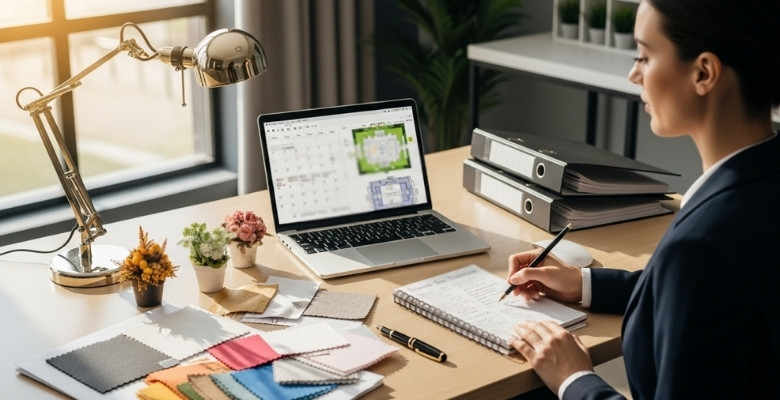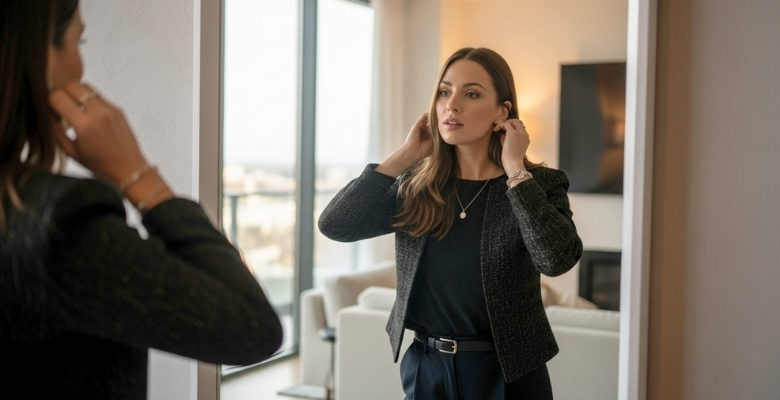Choosing the right academic conference attire can feel like a challenge. Between presentations, panels, and networking dinners, it is easy to wonder what level of formality works best. The truth is, your clothing sets the tone for how others see you.
The question of what to wear to an academic conference is often asked because expectations vary. Presenters are usually expected to appear more formal, while attendees can adopt a slightly relaxed yet polished look. Men often choose dress shirts, slacks, or blazers, while women may wear blouses, skirts, or dresses. Comfortable shoes are recommended, and avoid overly casual outfits.
When your outfit is comfortable and professional, you not only respect the occasion but also boost your own confidence. Dressing thoughtfully makes conversations smoother, keeps you at ease during long sessions, and lets you focus on building meaningful academic and professional connections.
What to Wear to an Academic Conference?
Walking into an academic conference isn’t just about what you’ve prepared; it’s also about how you present yourself. Choosing the right attire helps you look professional, feel comfortable, and create the right impression in every interaction.

Presenter Attire
When presenting, your outfit should show authority and confidence while keeping distractions to a minimum. Think polished, structured pieces that let you focus on your delivery without worrying about comfort.
- Customized Blazer With Trousers or Skirt: Adds structure and ensures you look sharp on stage.
- Neutral or Light Blouse/Shirt: Keeps your appearance clean and works well under bright lights.
- Closed-toe Shoes: Polished loafers, oxfords, or low heels that are smart yet walkable.
- Minimal Accessories: A simple watch or subtle jewelry that doesn’t interfere with microphones.
Poster Session Attire
Poster sessions are interactive and require you to stand for long hours. Your outfit should balance smart presentation with all-day comfort.
- Knit Blazer or Cardigan: Professional but flexible enough for moving around.
- Breathable Top: Cotton or linen-blend fabrics to keep you fresh while speaking with attendees.
- Chinos or Ankle Pants: Fitted but non-restrictive, allowing you to stay comfortable on your feet.
- Supportive Shoes: Cushioned flats or loafers that handle extended standing time.
- Lightweight Bag: Easy to carry while holding essentials like notes and pens.
Attendee Attire
As an attendee, your role is to absorb knowledge, network, and move between sessions. Choosing the right academic conference outfit helps you stay comfortable and neat while still maintaining a professional look.
- Collared Shirt or Blouse: Smart enough for networking but comfortable for long sessions.
- Ponte or Customized Trousers: Versatile bottoms that look refined and resist wrinkles.
- Professional Dress or Knit Separates: Alternative options that are modest and easy to layer.
- Low-profile Dress Sneakers or Loafers: Stylish yet practical for walking between venues.
- Light Cardigan or Jacket: Handy for chilly or overly air-conditioned rooms.
Core Rules to Keep in Mind
Dressing for an academic conference doesn’t need to feel complicated if you stick to a few universal principles. If you are unsure about how to dress for an academic conference, these rules work across roles, seasons, and venues, helping you stay professional and comfortable without overthinking your outfit.
- Fit Comes First: Avoid extremes of too tight or too loose.
- Choose Breathable Fabrics: Cotton, linen-blend, ponte, or merino keep you fresh.
- Closed-toe Shoes: Essential for both professionalism and comfort.
- Avoid Shiny Fabrics or Loud Prints: Not flattering under conference lighting.
- Use a Neutral Base With One Accent: Simple and memorable.
- Always Carry a Smart Layer: Perfect for unpredictable room temperatures.
Quick Checklist Before You Go
- Blazer or cardigan for layering
- 2–3 breathable tops
- 1–2 pairs of tailored trousers or skirts
- Comfortable closed-toe shoes
- Neutral base colours + one accent accessory
- Professional bag that fits laptop, notes, and water
Dressing well to participate in the academic conference with peers and senior professionals is not about overcomplication, but about balance. Choose outfits that reflect professionalism and comfort, so you can focus fully on ideas, discussions, and meaningful connections that make these events truly worthwhile.
Dress Code Decoder: Business Casual vs Business Professional
When it comes to academic conferences, one of the most common questions is how formal you really need to dress. Some events lean casual, others expect a sharp professional look, and it’s not always obvious which one fits best. Having a proper knowledge of the dress code for academic conference settings can make your choices much easier. To help, here’s a clear breakdown you can use.
Comparison Table
|
Category |
Business Casual |
Business Professional |
|
Tops |
Collared shirt, blouse, or knit top. |
Button-down shirt or structured blouse. |
|
Bottoms |
Chinos, ankle pants, or modest skirt. |
Tailored trousers or pencil skirt. |
|
Layers |
Light cardigan or knit blazer. |
Suit jacket or fitted blazer. |
|
Shoes |
Loafers, ballet flats, or dress sneakers. |
Closed-toe pumps, loafers, or oxfords. |
|
Avoid |
Jeans, shorts, t-shirts, or overly bold prints. |
Sandals, casual sneakers, or flashy accessories. |
|
Example Look |
Blouse with chinos, loafers, and a lightweight cardigan. |
Dark blazer with a light shirt, tailored trousers/skirt, and polished closed-toe shoes. |
Tops
Business casual tops lean toward comfort while still looking neat, like collared shirts, knit blouses, or simple tops. Business professionals wear sharper, usually button-down shirts or structured blouses, often paired with blazers. Casual tops show approachability, while professional tops project authority and formality.
Bottoms
In business casual, bottoms like chinos, ankle pants, or modest skirts create a smart yet relaxed look. A business professional requires tailored trousers or pencil skirts, which signal structure and seriousness. Casual bottoms are flexible and travel-friendly, while professional bottoms create a polished impression suitable for speaking or high-level networking.
Layers
Business casual layers, such as cardigans or knit blazers, add polish without stiffness and work well for movement. Business professional layers are formal, fitted blazers or full suit jackets that frame the body. Casual layers are about comfort and adaptability, while professional layers emphasize sharp lines and authority.
Shoes
Shoes in business casual may include loafers, flats, or even neat dress sneakers, all comfortable yet tidy. Business professional shoes are more formal: closed-toe pumps, polished loafers, or oxfords. Casual footwear allows long wear and easy walking, while professional footwear signals readiness for key presentations or leadership roles.
Avoid
Business casual discourages jeans, shorts, t-shirts, or loud patterns that may seem careless. Business professionals avoid sandals, sneakers, or flashy accessories that distract from formality. These same standards are also reflected in the dress code for medical conferences, engineering conferences, and business conferences, where professionalism and credibility are equally expected.
By comparing each category side by side, it’s easier to decide when to choose business casual and when business professional is better. Once you know the difference, dressing for your next academic conference feels far less stressful and much more straightforward.
Seasonal and Venue Planner
Conference venues can feel very different depending on the climate and setting. One day, you might be moving through humid summer heat, the next, you could be sitting in a freezing ballroom. Each space calls for slightly different outfit choices. Here’s how to plan smartly.
Hot & Humid
Warm and sticky conditions can quickly make heavy fabrics uncomfortable. In this type of climate, your goal should be to stay cool while still looking polished. Choose breathable options and keep layers to a minimum so you remain fresh all day.
- Fabrics: Lightweight cotton, linen blends, and breathable knits that wick moisture.
- Layers: Skip heavy blazers; use airy cardigans or short-sleeve jackets.
- Footwear: Loafers or flats made from breathable materials.
- Extras: Carry a small pack of blotting wipes, and keep a water bottle handy to stay refreshed.
Cool & Dry
Dry weather often comes with cooler air, which can make thin fabrics feel uncomfortable. The trick is to pick slightly heavier materials and keep an extra layer ready. This ensures you look smart without shivering during long presentations or hallway discussions.
- Fabrics: Wool-blend trousers, ponte knits, or heavier cotton for warmth.
- Layers: A structured blazer or light sweater over a blouse or shirt.
- Footwear: Closed-toe shoes with socks for comfort.
- Extras: A scarf or shawl that can double as a wrap in colder lecture halls.
Outdoor Venues
Outdoor events often bring unpredictable weather, so flexibility is essential. Choose wrinkle-resistant fabrics, wear comfortable shoes with good grip, and keep light accessories ready to protect yourself from sudden sun or rain.
- Fabrics: Weather-friendly materials like cotton blends or wrinkle-resistant fabrics.
- Layers: A light jacket or cardigan that can be removed easily.
- Footwear: Comfortable shoes with grip, dress sneakers, or flats work well.
- Extras: Sunglasses, a sunhat, or a small umbrella, depending on the forecast.
Hotel Ballroom
Hotel ballrooms are famous for being either too cold or too warm, rarely in between. Preparing with versatile layers and mid-weight fabrics will save you the discomfort. Aim for neat, wrinkle-resistant choices that let you stay professional during long sessions.
- Fabrics: Mid-weight fabrics like ponte, crepe, or blended cottons that resist wrinkles.
- Layers: Always bring a blazer or cardigan since ballrooms are often over-air-conditioned.
- Footwear: Classic closed-toe shoes that are smart but wearable all day.
- Extras: A neat tote bag for notes and a travel-size lint roller for quick fixes.
Thinking about climate and venue before packing makes dressing for a conference far less stressful. With the right fabrics, layers, and extras, you’ll feel prepared for any setting and stay focused on what matters most, whether it’s academic discussions or selecting the right research conference attire.
Principles That Always Work
No matter what kind of academic conference you attend, there are a few simple style rules that always come in handy. These aren’t about trends or complicated choices; they’re about keeping things professional, comfortable, and easy to manage throughout the day. Keep these principles in mind to make getting ready less stressful and your appearance more consistent.
- Fit First: Clothes that fit properly instantly look better. Avoid items that are too tight or too loose since both can appear unpolished and distracting.
- Breathable Layers: Fabrics like cotton, ponte, or linen blends help you stay comfortable while moving between sessions, crowded halls, and lecture rooms.
- Closed-toe Comfort: Always go for shoes that cover your toes and allow you to walk easily. Conferences often involve lots of walking, so comfort matters as much as appearance.
- Matte on Stage: Shiny fabrics may look good at home, but can reflect light harshly on stage or in photos. Matte fabrics always appear smoother and more professional.
- Pockets or Clip Points: Outfits with pockets or spots to clip a microphone or carry your badge make the day more practical and less awkward.
- Neutral Base + One Accent: Building around neutral colours (black, navy, grey) keeps things professional. Add one accent piece like a scarf, tie, or accessory to show personality without overdoing it.
These principles act as a foundation for any conference outfit. By following them, you can avoid common mistakes and dress with confidence every time. The same guidelines apply when you need to wear proper attire for scientific conferences, business conferences, or technology conferences, where polish and practicality are equally important.
Layering and Fabrics That Survive a Full Day
Conference days are long, and you’ll often move between warm outdoor walks, chilly ballrooms, and packed lecture halls. That’s why layering and fabric choices matter just as much as style. Picking the right materials keeps you comfortable and presentable from morning to evening, while still aligning with the broader academia dress code that values professionalism and practicality in every setting.
Fabric Cheat Sheet
The right fabric can make the difference between feeling fresh and feeling wrinkled and tired halfway through the day. Choosing smart materials ensures you look neat without constant touch-ups and stay comfortable across different temperatures.
- Linen-blend: Breathable and light, but less wrinkle-prone than pure linen.
- Cotton Poplin: Crisp and cool, great for shirts that stay sharp.
- Ponte Knit: Stretchy yet structured, perfect for trousers or dresses that won’t sag.
- Merino Wool: Lightweight and regulates temperature well, even indoors.
- Wrinkle-resistant Blends: Easy-care fabrics that save you from ironing and keep you looking fresh.
Base-Layer and Anti-wrinkle Tactics
Even the best fabric can look tired without proper care. Simple layering tricks and quick anti-wrinkle methods can help you stay sharp without needing a full wardrobe change during a busy conference schedule.
- Base-layers: A thin cotton tee or moisture-wicking undershirt can keep you comfortable under blazers and reduce sweat marks.
- Anti-wrinkle Hacks: Hang clothes in the bathroom while showering to release creases, or choose blends that naturally resist wrinkling.
- Smart Layering: Always keep a versatile cardigan or blazer handy so you can adjust quickly to different room temperatures.
Fast Refresh Kit
Unexpected wrinkles or stains are almost guaranteed at some point. A small refresh kit can save the day and keep you looking put together without needing a full wardrobe backup.
- Travel Steamer: Small enough for a suitcase but powerful enough to smooth out last-minute wrinkles.
- Lint Roller: Keeps dark fabrics clean and professional-looking, especially in bright lighting.
- Stain Pen: A lifesaver for coffee spills or lunch mishaps during a busy day.
Smart fabric choices, thoughtful layering, and a tiny refresh kit are the easiest ways to stay polished all day. With these strategies, you’ll feel confident and prepared no matter how long or unpredictable the conference schedule becomes.
How Do You Choose Shoes and Bags for Long Conference Days?
Conferences mean a lot of walking, standing, and carrying things around, often more than you expect. The right shoes and bag can make or break your day. Comfort, practicality, and a polished look should all work together here. Let’s break it down.
Shoes
Your shoes will carry you through long hours of movement, from lecture halls to networking events. The best choice is something that looks professional but feels supportive, such as loafers, low block heels, or clean dress sneakers. It is always smart to break them in beforehand rather than wearing them for the first time on the conference day, as this prevents painful blisters and keeps you comfortable from morning to evening.
Socks and Insoles
What you wear inside your shoes can be just as important as the shoes themselves. Moisture-wicking socks help keep your feet dry and fresh, even after a busy day filled with walking and standing. Adding blister-prevention insoles or cushioned pads can provide extra support and reduce friction, making your shoes easier to wear over multiple days without discomfort.
Bags
Your bag is more than just an accessory during a conference. It becomes your mobile office, carrying essentials like your laptop, notebook, and chargers. A slim backpack or a structured tote works best, offering enough room for everything without looking bulky. Staying organized with a small cable pouch and keeping a power bank ready ensures your devices remain charged, so you never miss a note or a networking opportunity.
Choosing practical shoes and a reliable bag makes the difference between a smooth day and an exhausting one. With the right picks, you will move confidently, stay organized, and keep your energy focused where it matters, on the conference itself.
Colors and Accessories That Photograph Well
Photos and videos are a big part of most academic conferences, whether it is for official coverage or casual networking snapshots. The way colors and accessories appear on camera can make a difference in how polished and professional you look. Paying attention to these small details helps you stand out in a good way.
Bright, shiny fabrics may look appealing in person, but they tend to reflect harshly under stage lights and cameras. This can create glare and make your outfit appear messy on screen. Instead, solid colors or subtle patterns come across much cleaner and sharper. Classic shades like navy, grey, black, or soft pastels not only look professional but also photograph well.
Accessories should work as a finishing touch rather than steal attention. A single statement piece, like a scarf, tie, or necklace, can add personality without overwhelming your outfit. Watches with a quiet, simple design are better than flashy ones, which may catch too much light or create distractions during presentations. The key is balance: professional first, stylish second.
Choosing the right colors and accessories ensures you look as polished on camera as you do in person. By keeping things simple, subtle, and thoughtfully chosen, you can feel confident when the spotlight or camera naturally comes your way.
Day-to-Dinner Switch Quickly
Evening events often follow long days at conferences, and you rarely have the time for a full outfit change. With a few smart swaps, you can quickly refresh your look and step into dinner looking polished and confident.
Quick Switch Steps
- Change Your Shoes: Swap flats or sneakers for loafers, pumps, or dressier shoes to instantly sharpen your look.
- Add a Blazer: Layering a blazer over your outfit gives a structured, evening-ready finish.
- Switch Your Bag: Replace a tote or backpack with a sleek cross-body or clutch for a cleaner style.
- Use an Accessory: A scarf or tie adds personality and makes the outfit look intentional.
- Do a Quick Touch-up: Keep a small kit with compact powder, lip balm, or deodorant for a fast refresh.
These quick steps save you from overpacking and let you move seamlessly from daytime sessions to evening dinners. With just a few tweaks, you can stay professional, stylish, and ready for any conference event.
Mistakes and Quick Fixes
Even with the best intentions, it is easy to choose outfits that feel comfortable but send the wrong message in a professional setting. The good news is that most of these missteps have simple fixes. Similar to the dress code for seminar events, where neatness and professionalism are expected, these guidelines help you avoid common errors. Here are some mistakes and what you can do instead.
Issue → Fix Table
|
Mistake |
Quick Fix |
|
Wearing wrinkly linen that looks sloppy |
Choose a linen-blend or wrinkle-resistant fabric that holds its shape all day. |
|
Choosing brand-new shoes that cause blisters |
Break them in a week earlier and use cushioned insoles for comfort. |
|
Picking a deep neckline for a stage talk |
Add a camisole or choose a higher neckline that photographs better. |
|
Wearing flip-flops or overly casual shoes |
Opt for loafers, closed-toe flats, or low block heels for a polished look. |
|
Overloading with noisy or flashy accessories |
Keep one subtle statement piece and a quiet watch instead. |
|
Wearing overly bold patterns that distract |
Stick to solids or subtle prints that look cleaner on stage and in photos. |
|
Choosing clothes that are too tight or baggy |
Go for well-fitted outfits that move comfortably without looking sloppy. |
|
Carrying oversized or casual bags |
Pick a structured tote or slim backpack that looks professional and practical. |
By being mindful of these simple mistakes, you can make quick adjustments that keep your outfit professional and comfortable. Each fix is easy, but together they help you create a confident look that works perfectly for any conference setting.
Frequently Asked Questions
Academic conferences bring a mix of questions, especially about what works and what doesn’t when it comes to clothing. While the main guide covers the essentials, there are still a few smaller but common questions many attendees wonder about. Here are clear answers to help.
Can I Wear Cultural or Traditional Outfits to a Conference?
Yes, you can wear cultural or traditional outfits as long as they look neat and professional. Many attendees appreciate authentic styles that show personality. Just avoid clothing that feels too casual or distracting for academic settings.
How Many Outfits Should I Pack for a Three-day Conference?
Pack two to three main outfits that can be mixed and matched. Add an extra top or blazer for variety. With smart planning, you can create different looks without carrying too many clothes.
Are Bright Colors Acceptable at Academic Conferences?
Bright colors are fine in moderation, especially if paired with neutrals. A colorful scarf, tie, or blouse can add personality. Just avoid overly loud patterns or shiny fabrics that can look distracting under lights.
What Kind of Accessories Are Appropriate for Networking Events?
Keep accessories minimal and professional. A simple watch, a pair of stud earrings, or a subtle necklace works well. The goal is to look polished while ensuring your outfit, not your accessories, takes the spotlight.
Do I Need a Different Outfit for Evening Receptions?
Not necessarily. You can wear the same outfit with a few adjustments. Switching shoes, adding a blazer, or changing your bag can quickly refresh your look for an evening reception without needing a full change.
Can I Wear Comfortable Sneakers to a Conference?
Yes, as long as they look neat and clean. Low-profile dress sneakers can be a good option if you’ll be walking a lot. Avoid running shoes or overly casual designs that feel out of place.
How Do I Handle Last-minute Stains or Wrinkles?
A small refresh kit can be a lifesaver. Carry a stain pen, a travel-sized lint roller, and wrinkle-release spray or a mini steamer. These quick tools keep you looking professional throughout the day.
Concluding Words
Dressing for an academic conference should never feel complicated. With the right choices, you can balance professionalism and comfort while presenting yourself with confidence. A well-planned outfit helps you focus on ideas, networking, and opportunities rather than worrying about appearance.
The question of what to wear to an academic conference often comes down to choosing pieces that are neat, practical, and suited to the occasion. Simple rules such as picking breathable fabrics, comfortable shoes, and modest styles ensure you always look polished without overthinking.
By planning ahead and making small but smart choices, you can step into any session, panel, or dinner prepared. Your outfit becomes an asset that supports your goals, allowing you to make the most of every moment at the conference.








